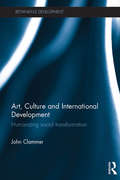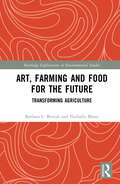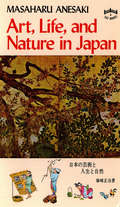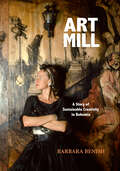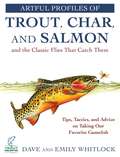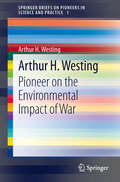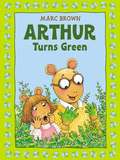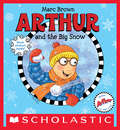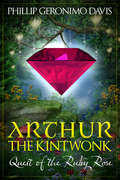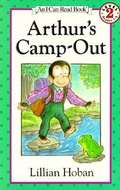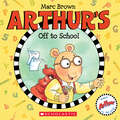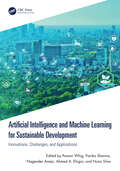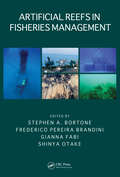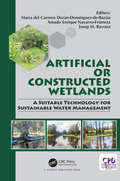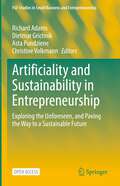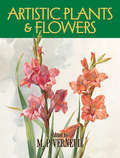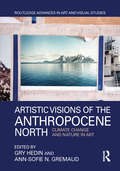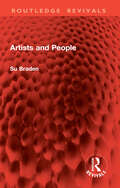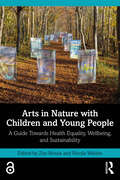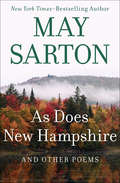- Table View
- List View
Art, Animals, and Experience: Relationships to Canines and the Natural World (Routledge Advances in Art and Visual Studies)
by Elizabeth SuttonElizabeth Sutton, using a phenomenological approach, investigates how animals in art invite viewers to contemplate human relationships to the natural world. Using Rembrandt van Rijn’s etching of The Presentation in the Temple (c. 1640), Joseph Beuys’s social sculpture I Like America and America Likes Me (1974), archaic rock paintings at Horseshoe Canyon, Canyonlands National Park, and examples from contemporary art, this book demonstrates how artists across time and cultures employed animals to draw attention to the sensory experience of the composition and reflect upon the shared sensory awareness of the world.
Art, Culture and International Development: Humanizing social transformation (Rethinking Development)
by John ClammerCulture is not simply an explanation of last resort, but is itself a rich, multifaceted and contested concept and set of practices that needs to be expanded, appreciated and applied in fresh ways if it is to be both valued in itself and to be of use in practical development. This innovative book places culture, specifically in the form of the arts, back at the centre of debates in development studies by introducing new ways of conceptualizing art in relation to development. The book shows how the arts and development are related in very practical ways – as means to achieve development goals through visual, dramatic, filmic and craft-inspired ways. It advocates not so much culture and development, but rather for the development of culture. Without a cultural content to economic and social transformation the problems found in much development – up-rooting of cultures, loss of art forms, languages and modes of expression and performance – may only accelerate. Paying attention to the development of the arts as the content of development helps to amend this culturally destructive process. Finally, the book argues for the value of the arts in attaining sustainable cultures, promoting poverty alleviation, encouraging self-empowerment, stimulating creativity and the social imagination, which in turn flow back into wider processes of social transformation. Discussion questions at the end of each chapter make this book ideal to help foster further thinking and debate. This book is an inspiring read for postgraduate students and researchers in the fields of development studies, cultural studies and sociology of development.
Art, Farming and Food for the Future: Transforming Agriculture (Routledge Explorations in Environmental Studies)
by Nathalie Blanc Barbara L. BenishThis book explores the impact of artistic experiments in inspiring people to turn away from current food consumerism and take an active role in preserving, sustaining, and protecting the environment. As artists are expanding their practice into social justice and community concerns, erasing traditional forms of expression and integrating others, the culture around food and its production has been added to a new vocabulary of experiential art. The authors measure the impact of such experiments on local food consumption and production, focusing on education and youth, both in the surrounding community and culture at large. They suggest how these projects can be up-scaled to further encourage sustainable solutions for our environment and communities. The book explores the reflections and motivations of case study practitioners in urban and rural areas and, through interviews, engages with artists who are pioneering a new trend to create hubs of activity away from traditional art spaces in cities to follow a non-hierarchal practice that is de-centralized and communally based. This book will be of great interest to academic readers concerned with issues related to environmental aesthetics, eco-design, eco-criticism, culture, heritage, memory, and identity, and those interested in the current debates on the place of aesthetics and culture in sustainability.
Art, Life, and Nature in Japan
by Masaharu Anesaki Terence BarrowThe artistic and philosophical heritage of Japan has a special meaning for the modern world. During the present century, Japanese thought and Japanese art have exerted a strong influence on the western mind. Art, Life, and Nature in Japan takes us to the roots of Japanese culture and the origins of this influence.In this brief but deeply meaningful book Masaharu Anesaki provides a panoramic view of Japanese culture, with particular emphasis on the spirit of Japanese art. The book has, in fact, established itself as a classic, and it ranks with such other valuable works of its time as The Book of Tea, in which Kakuzo Okakura deals with a similar theme.Anesaki expresses himself in crystal-clear English to convey a message that is significant today as it was before World War II, when his book first appeared. He advocates peace and a turning inward to the beauty of art and nature. He is as familiar with the Zen philosophy of the samurai and the tea master as with sentiments of ancient court noblemen and the quiet thought of a humble peasant.
ArtMill: A Story of Sustainable Creativity in Bohemia
by Barbara BenishThe story starts in totalitarian darkness (Czechoslovakia before 1989) and gradually lays out a groundwork for how creativity within community can influence and change society. All of this is rooted in the connection to the natural world, be it local sustainable farming practices, rural innovations, or international policies with governmental bodies on the global level. The book is a success story for a female artist (the author) who found a way to build a life in a rural, posttotalitarian, foreign country, with virtually no income, through her love of the place. It is a testament to the resilience of the people of that small nation that was sacrificed in the tumultuous chess game of colonial superpowers dividing up Europe after the devastation of WWII. It is a textbook protocol on how to instill civil society from the ground up, so that democratic life can thrive. This is a story that has been told in small pieces over the years in essays, catalogues, lectures, and radio and television interviews but needed the deeper context of a fulllength book.
Artful Profiles of Trout, Char, and Salmon and the Classic Flies That Catch Them: Tips, Tactics, and Advice on Taking Our Favorite Gamefish
by Dave Whitlock Emily WhitlockIt is with passion and clarity that Dave Whitlock describes trout, salmon, char, and how to fly fish for them. Artful Profiles of Trout, Char, and Salmon and the Flies That Catch Them is a collection of articles spanning Whitlock's career, all of which are essential reading for any fly-fisher. Over the past fifty years, he has amassed an incredible amount of knowledge and written a large number of articles, many of which appeared in Trout magazine and are featured within. Here, Whitlock deftly, accessibly, and thoroughly goes through a vast range of topics, including:Insights into the many subspecies of trout, char, and salmon Casting methods for every scenario Drawing out shy fish Types of flies for different waters and situations Accurately imitating food sources And much more! Discover a wealth of information consolidated by an experienced and devoted angler. Artful Profiles of Trout, Char, and Salmon and the Flies That Catch Them is absolutely packed with tried-and-true tips, tactics, and techniques that are presented concisely alongside colorful illustrations by Whitlock himself. This book is a must have for anyone with an interest in angling, whether they are an absolute beginner, or an experienced angler with years under their belts.
Arthur Goes to Camp
by Marc BrownPoor Arthur. He and the boys can't seem to do anything right at Camp Meadowcroak. Awful food, poison ivy, and losing to the girls in every sport are more than he can take. Arthur plots to run away just as the other campers plot to win the big scavenger hunt against their archrivals at Camp Horsewater. What happens when the two schemes collide makes a rousing finale to a funny, reassuring picture book. Arthur Goes to Camp brings more good laughs and learning to the growing number of Arthur fans.
Arthur H. Westing: Pioneer on the Environmental Impact of War (SpringerBriefs on Pioneers in Science and Practice #1)
by Arthur H. WestingSince the 1960s the environment has become an issue of increasing public concern in North America and elsewhere. Triggered by the Second Indochina War (Vietnam Conflict) of 1961-1975, and further encouraged by the International Conference on the Human Environment, held in Stockholm in 1972, the environmental impact of war emerged and grew as a topic of research in the natural and the social sciences. And in the late 1980s this led additionally to a focus and debate on environmental security. Arthur Westing, a forest ecologist, was a major pioneer contributing and framing both of those debates conceptually, theoretically, and empirically, starting with Harvest of Death: Chemical Warfare in Vietnam and Cambodia (1972) (co-authored with wildlife biologist E.W. Pfeiffer and others). As a Senior Researcher at the Stockholm and Oslo International Peace Research Institutes (SIPRI and PRIO), and as a Professor of Ecology at Windham and Hampshire Colleges, Westing authored and edited books on Ecological Consequences of the Second Indochina War (1976), Weapons of Mass Destruction and the Environment (1977), Warfare in a Fragile World: Military Impact on the Human Environment (1980), Herbicides in War: the Long-term Ecological and Human Consequences (1984), Environmental Warfare: a Technical, Legal and Policy Appraisal (1984), Explosive Remnants of War: Mitigating the Environmental Effects (1985), Global Resources and International Conflict: Environmental Factors in Strategic Policy and Action (1986), Cultural Norms, War and the Environment (1988), Comprehensive Security for the Baltic: an Environmental Approach (1989), and Environmental Hazards of War: Releasing Dangerous Forces in an Industrialized World (1990) --- as well as authoring numerous UN reports, book chapters, and journal articles. This volume combines six of his pioneering contributions on the environmental consequences of warfare in Viet Nam and in Kuwait, on the environmental impact of nuclear war, and on legal constraints and military guidelines for protecting the environment in wartime
Arthur Jumps into Fall
by Marc BrownArthur the aardvark can’t leave well enough alone in this autumn adventure—from the creative producer of PBS’s Peabody and Emmy Award-winning TV series.Arthur has a big job to do: raking all of the leaves in the backyard. He tries to focus, but jumping in the leaves is way more fun than raking them. How will he ever finish? Arthur will need some help from his friends for this task!
Arthur Turns Green
by Marc BrownArthur is full of ideas when it comes to doing his part to save the planet. But is he actually turning green? Arthur comes home from school and begins sneaking around the house, taking notes and talking about a Big Green Machine. D.W. is suspicious of her brother's weird behavior, and when Arthur shows up late for dinner with green hands, she really gets the creeps! Will the Big Green Machine get her, too? Find out how Arthur's secret project convinces his entire family to turn green! Get to know your favorite aardvark all over again in the first new Arthur Adventure in nearly a decade!
Arthur and the Big Snow
by Marc BrownEveryone’s favorite aardvark is back in a wonderful winter tale—from the creative producer of PBS’s Peabody and Emmy Award-winning TV series.It’s the perfect snow day, and Arthur is excited to spend it with his friends. But because his little sister D.W. is too small, he has to wait for the snow plow to come by. Arthur waits so long, his friends have finished sledding! Will his snow day get any better? With a little help from Dad, Arthur realizes some things are worth waiting for.
Arthur the Kintwonk: The Quest of the Ruby Rose
by Phillip Geronimo DavisArthur the Kintwonk is a story about a reluctant Kintwonk, an ancient race from outer space, who is deemed to be the next King of the Kintwonks. His quest is to take a bag of rubies to the hall of the Mountain Fring. He is weylead by skullduggers, Pirates, Pimps and a host of other Neer do wells. He is aided and abetted by a host of friends from Mother Earth and Outer Space. Failure to succeed would change the world and doom Mankind forever.
Arthur's Camp Out (An I Can Read Book)
by Lillian HobanBored with spring vacation, Arthur decides to go alone on an overnight field trip in the woods behind his house.
Arthur's Off to School (Arthur [brown] Ser.)
by Marc BrownEveryone's favorite aardvark, Arthur, is back in this exciting reissue -- just in time for school!Everyone's favorite aardvark, Arthur, is back in this exciting reissue -- just in time for school!Arthur and his friends are getting ready for school! Get a sneak peek at every character's morning routine, from Francine preparing for recess to the Brain searching for his lost lizard. D.W. wishes she could join in the fun, but she's still too young for school. Can she find her own way to help Arthur get ready? Part of an exciting new seasonal 8x8 Arthur publishing re-release with Scholastic, sure to engage and delight a whole new generation of Arthur fans!
Artificial Intelligence and Machine Learning for Sustainable Development: Innovations, Challenges, and Applications
by Ahmed A. Elngar Pawan Whig Nuno Silva Nagender Aneja Pavika SharmaArtificial Intelligence and Machine Learning for Sustainable Development is a comprehensive exploration of how artificial intelligence (AI) and machine learning (ML) technologies are revolutionizing the field of sustainable development.The book examines cutting-edge innovations, practical applications, and potential challenges in harnessing AI and ML to address global sustainability issues. It offers insights into how these technologies can optimize resource management, improve environmental monitoring, enhance decision-making processes, and promote equitable, eco-friendly solutions. This book would be of special interest to researchers, policymakers, and practitioners seeking to leverage cutting-edge technology for a more sustainable future.
Artificial Reefs in Fisheries Management (CRC Marine Biology Series)
by Stephen A. Bortone Shinya Otake Frederico Pereira Brandini Gianna FabiWhile artificial reefs may have much to offer, they remain an anecdote in the greater scheme of fisheries management, primarily due to the lack of data specific to validating their use. Based on papers presented at the 9th Conference on Artificial Reefs and Artificial Habitats (CARAH) and also including original articles written for this reference,
Artificial or Constructed Wetlands: A Suitable Technology for Sustainable Water Management
by María del Durán-Domínguez-de-Bazúa Amado Enrique Navarro-Frómeta Josep M. BayonaArtificial or constructed wetlands are an emerging technology particularly for tropical areas with water scarcity. For big cities, the sustainable management of water resources taking into account proper use is always challenging. The book presents case studies illustrating the above. As plants and microorganisms are a fundamental part of the correct functioning of these systems, their contribution to the degradation of the organic matter and to the removal and transformation of the pollutant compounds present in the wastewaters is also a highlight of this book.
Artificiality and Sustainability in Entrepreneurship: Exploring the Unforeseen, and Paving the Way to a Sustainable Future (FGF Studies in Small Business and Entrepreneurship)
by Richard Adams Dietmar Grichnik Asta Pundziene Christine VolkmannThis open access edited volume explores the past, present, and future of artificiality and sustainability in entrepreneurship – the unforeseen consequences and ways to advance to a sustainable future. In particular, it connects artificiality, sustainability and entrepreneurship, intertwining artificial with the specific phenomenon of those novel digital technologies that provoke continuous and significant change in our lives and business. Unlike digital entrepreneurship research, which focuses on digital technology development and management, this book covers processes and mechanisms of sustainable adaptability of entrepreneurs, the business logic of start-ups, and the collaborative behaviours under the mass digital transformation, including the prevalence of artificial intelligence. Some of the questions that this book answers are as follows: How has entrepreneurship reacted to such challenges previously? What lessons have been learned and need to be carried forward? How can entrepreneurship and the artefacts of entrepreneurship respond to current challenges? What should be the mindset of the entrepreneur to assure sustainable adaptation? How to embrace and embed the new business logic?
Artistic Plants and Flowers (Dover Fine Art, History of Art)
by M. P. VerneuilFrom one of the biggest names in Art Nouveau design comes this splendid visual encyclopedia of superior artistic studies of plants and flowers. Its 120 images were selected from a rare, century-old, four-volume set of botanical illustrations. Cherry blossoms, clematis, crown imperial, and other specimens appear side by side in full-page plates that contrast magnificent color renditions with meticulous black-and-white drawings.A leading designer in the Art Nouveau movement, M. P. Verneuil was particularly interested in the decorative potential of flowers, and he created countless realistic and imaginative floral patterns. In this collection, he spotlights the work of such popular artists as Alphonse Mucha, M. Méheut, and other distinguished illustrators. Captions identify each image. A very useful, wide-ranging reference, this volume will delight artists and lovers of botanical illustration.
Artistic Visions of the Anthropocene North: Climate Change and Nature in Art (Routledge Advances in Art and Visual Studies)
by Gry Hedin Ann-Sofie N. GremaudIn the era of the Anthropocene, artists and scientists are facing a new paradigm in their attempts to represent nature. Seven chapters, which focus on art from 1780 to the present that engages with Nordic landscapes, argue that a number of artists in this period work in the intersection between art, science, and media technologies to examine the human impact on these landscapes and question the blurred boundaries between nature and the human. Canadian artists such as Lawren Harris and Geronimo Inutiq are considered alongside artists from Scandinavia and Iceland such as J.C. Dahl, Eija-Liisa Ahtila, Toril Johannessen, and Björk.
Artists and People (Routledge Revivals)
by Su BradenFirst published in 1978, Artists and People examines the formal attempts by arts administrators to set up schemes for artists to work in community contexts. The experience of creative artists who have taken up ‘residencies’ in schools, libraries and art centres is contrasted with the unique forms of expression developed by local communities themselves in new towns, housing estates, rural centres, and inner cities, in areas ranging from Tower Hamlets in London, through Craigmillar in Scotland, to new towns such as Telford and Milton Keynes.The book takes the form of a series of accounts of the experiences of artists and communities who have come together in contexts not usually seen as arenas for the arts. Su Braden looks at these experiences in the light of the philosophy that the right to artistic expression is a basic human freedom for everybody, not just for ‘artists’. In writing the book she has drawn on her experience as a community arts worker and she assesses the effect of the traditional structures (the theatre, gallery and concert hall) both on the form of art itself and the critical relationship which is intrinsic to its development. By looking at the first-hand experience of artists and local people, she has documented the dependence of much contemporary art for its form and the nature of its critical relationships on the formal structure offered by traditional outlets. In contrast, the examination of the relationship between artists and communities who have developed creative forms out of a more spontaneous recognition of mutual needs and talents reveals a new perspective on the social value of liberating artistic expression from its formal restraints.
Arts Education and Sustainability in a Time of Crisis (Yearbook of Arts Education Research for Cultural Diversity and Sustainable Development #4)
by WoongJo Chang Shin-Eui ParkThis book is a result of the 4th UNESCO-UNITWIN Symposium that took place in Seoul, Korea, on May 25 and 26, 2021. Held online for the first time due to the Covid-19 pandemic, distinguished arts management and cultural education scholars addressed a timely array of issues, including the power of arts participation to transform behavior and perceptions, inclusivity in arts education, the disruptions and opportunities of the lockdown, the power of arts creativity in broader problem solving, the role of local arts educators on the transcultural horizon, and the role of international cooperation in reconstituting vibrant national arts scenes. Encompassing visual, written, and performance arts education from primary through higher education, this book provides a unique window into the power of the arts to meet the harrowing tests we continue to face in the context of the global pandemic. The book offers a unique perspective that is both international in scope and addresses local responses to an unprecedented global pandemic with an emphasis on the Korean and East Asian context.
Arts in Nature with Children and Young People: A Guide Towards Health Equality, Wellbeing, and Sustainability
by Nicola Walshe Zoe MoulaThis novel text brings together research and practice on the intersection between arts and nature and their impact on children and young people’s wellbeing, health equality and sustainability.Existing literature focuses on either the impact of the arts or the impact of being in/with nature on children’s and young people’s wellbeing. However, the intersection between the two – arts and nature – and their combined effect on wellbeing has received limited attention. Through five research-based and seven practice-based chapters, this book draws upon arts-in-nature practices that incorporate visual arts, music, movement, drama and poetry, in a range of natural environments, such as forests, beaches, greenhouses, parks, community areas and school playgrounds.Arts in Nature with Children and Young People will appeal to anyone working with children and young people, including mental health and healthcare professionals, teachers, researchers, artists, and arts therapists. It is also an accessible guide for parents and families looking for inspiration and ideas for creative and outdoor activities.
As An Oak Tree Grows
by G. Brian KarasThis inventive picture book relays the events of two hundred years from the unique perspective of a magnificent oak tree, showing how much the world can transform from a single vantage point. From 1775 to the present day, this fascinating framing device lets readers watch as human and animal populations shift and the landscape transitions from country to city. Methods of transportation, communication and energy use progress rapidly while other things hardly seem to change at all. This engaging, eye-opening window into history is perfect for budding historians and nature enthusiasts alike, and the time-lapse quality of the detail-packed illustrations will draw readers in as they pore over each spread to spot the changes that come with each new era. A fact-filled poster is included to add to the fun.
As Does New Hampshire: And Other Poems
by May SartonMay Sarton&’s exquisitely rendered tribute to her home state Over the course of her career, May Sarton wrote on a range of topics and places in both prose and poetry, and traveled across the world in search of new subjects. There is, however, one place that she always returned to in the end: Nelson, New Hampshire. Written in honor of the town&’s bicentennial, As Does New Hampshire follows the course of a year in this rural hamlet. Sarton gracefully describes the ever-present role of nature, which always reminds humans that their presence on earth is temporary. She conveys both the beauty and the difficulty of a New England winter, and the full bloom of spring and summer. Above all, though, As Does New Hampshire is a lasting tribute not only to Sarton&’s home, but to the greater concept of home found in the heart of every reader.

